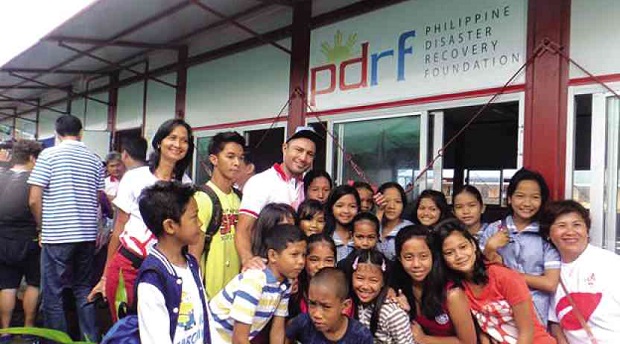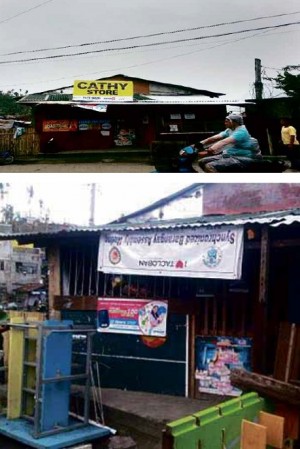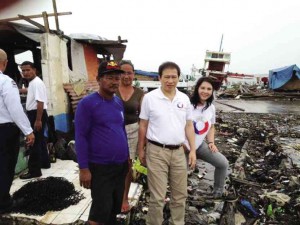For Yolanda–and future calamities–the private sector stands ready

ACTOR Derek Ramsay poses with schoolchildren during his visit to a school house project in Tacloban put up by PDRF with the help of its member companies
As is often the case when major natural calamities strike, the country’s largest private firms rush to the aid of affected communities. Some do it as part of their corporate social responsibility programs, while some do it in the hopes of gaining positive publicity.
And as is often the case, there is a sense among observers that companies which try to outdo each other in the field of business also try to outdo each other in the field of disaster response and recovery.
However, in the wake of Supertyphoon “Yolanda” (international codename: Haiyan), the country’s largest conglomerates renewed their commitment to work together to aid victims of one of the strongest storms ever to make landfall in recorded history.
Enter the Philippine Disaster Recovery Foundation (PDRF)— the private sector’s main vehicle for disaster management. It was formed in the wake of Tropical Storm Ondoy (Ketsana) in 2009, but its mission was revitalized in the wake of Yolada’s devastation last November 2013.
“The damage caused by the typhoon is massive, and one company working alone could easily be overwhelmed by the scope of the relief effort that needs to be done,” said PDRF president Rene “Butch” Meily, who describing the rationale for the group’s existence.
Article continues after this advertisementThe government has pegged the damage caused by Yolanda to several cities and provinces in the Visayas at close to P600 billion, while it estimates that the entire rehabilitation effort would collectively cost over P360 billion.
Article continues after this advertisement
BEFORE and after pictures of sari-sari stores. Twenty sari-sari stores in Tacloban City are now back in business due to the livelihood program of the Philippine Disaster Recovery Foundation (PDRF) and wholesale distributor Suy Sing Commercial Corp
Led by Ayala Corp. chair and CEO Jaime Augusto Zobel de Ayala, PLDT group chair Manuel Pangilinan and Manila Archbishop Luis Antonio Cardinal Tagle, the group also brings together corporate giants like the Aboitiz Equity Ventures, the Shell group of companies, Magsaysay Maritime Corp., First Gen Corp., Gawad Kalinga, the Land Bank of the Philippines, the World Wildlife Fund, Phinma along with a host of advisers who are experts in their fields.
“More than pooling our material and financial resources, we also draw on each others’ expertise,” Meily says. “Together, we achieve more.”
PDRF’s efforts in the devastated city of Tacloban and the surrounding provinces is anchored on a five-pillared program consisting of interventions in shelter, livelihood, education, environment and “WISH” (water, infrastructure, sanitation and health).
Each pillar is an autonomous unit headed by team leaders in charge of coordinating the activities of corporate members and donors who have chosen to support this particular sector.
For example, companies involved in PDRF’s education pillar are tasked with providing support for a Department of Education-supervised feeding program that would benefit 27,000 students in the affected communities. The education cluster is also in charge of setting up “temporary learning tents” and well as working with local government units for the reconstruction and repair of classrooms.
In the livelihood pillar headed by Rapa Lopa, the group helped restore the access of local sari-sari stores to basic goods through the help of SuySing Corp. It also restored local supply chains for the delivery of consumer items to local communities, as well as helped fund the acquisition of fishing boats to allow fishermen to resume their livelihood.
PDRF has similar modules for each of the three other pillars which are deemed critical to aid residents of the typhoon-devastated areas get back on their feet.
Meily explains that the PDRF model is also flexible enough to allow corporations to participate in ways they are comfortable with.
Companies with expertise in disaster relief and recovery can support PDRF programs by sending their personnel to work directly with communities on the group. Meanwhile, those without the required experience can participate in the effort by contributing funds or material resources that can be used to support PDRF’s programs.
More importantly, the business leaders behind PDRF recognize that large-scale calamities like Yolanda are now “the new normal” for a disaster-prone country like the Philippines.
“So apart from disaster response, PDRF is really focusing on disaster preparedness,” says Meily.
In particular, he adds that PDRF is working on a program that could be implemented in case Metro Manila is hit by “The Big One”—a strong earthquake that scientists believe has the potential to cause massive devastation and loss of life in the heavily built-up urban environment.
“We have to accept the reality that we will have more disasters in the future, and we all have to be prepared for it,” Meily adds.
The PDRF chief notes, however, that the biggest asset the group brings to bear during any calamity is equally or sometimes more valuable than financial and materials resources.
“We don’t have the billions [needed for the rehabilitation and reconstruction efforts],” he says, pointing instead to the private sector’s speed of execution and management expertise can spell the difference between life and death for calamity victims.
He says this efficiency and speed of execution compliments the government’s larger resources, and the result is a whole that is greater than the sum of its private and public sector parts.
“The needs are so big, so we’re here to support each other’s efforts,” Meily states.
Indeed, if large-scale disasters and calamities are the new normal, close cooperation between the public and private sectors is a good formula to have.
